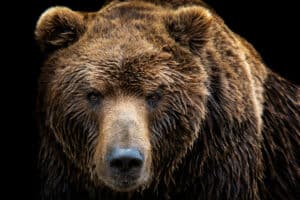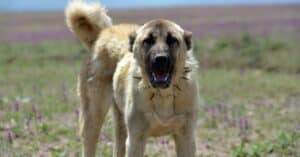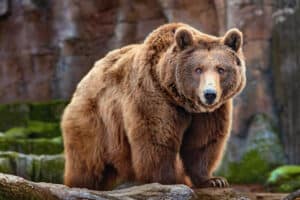Located in the Mountain West division of the United States, Montana contains some of the wildest landscapes in the U.S. The fourth-largest state in the country also ranks as the eighth-least populated and third-least densely populated state. Its lack of people and wide open spaces give rise to one of its unofficial nicknames, Big Sky Country. The eastern half of the state features plains, prairies, and badlands. Meanwhile, rugged mountains dominate the state’s western half. Its thousands of rivers crisscross the landscape and flow into multiple watersheds, including the Pacific Ocean, the Gulf of Mexico, and Hudson Bay.
Montana boasts an incredibly diverse array of wildlife. Within the state, you can find 90 fish species, 427 bird species, 117 mammal species, and thousands of invertebrates.
It also possesses the largest population of grizzly bears in the contiguous United States. Montana’s history books are littered with famous bears, including Two Toes, Ethyl, Old Terror, and Gertie the Grizzly. But which of Montana’s bears measured the largest?
Keep reading to discover the largest bear ever caught in Montana. You’ll also learn about the types of bears you can find in Montana and where those bears live.
The Largest Bear Ever Caught in Montana
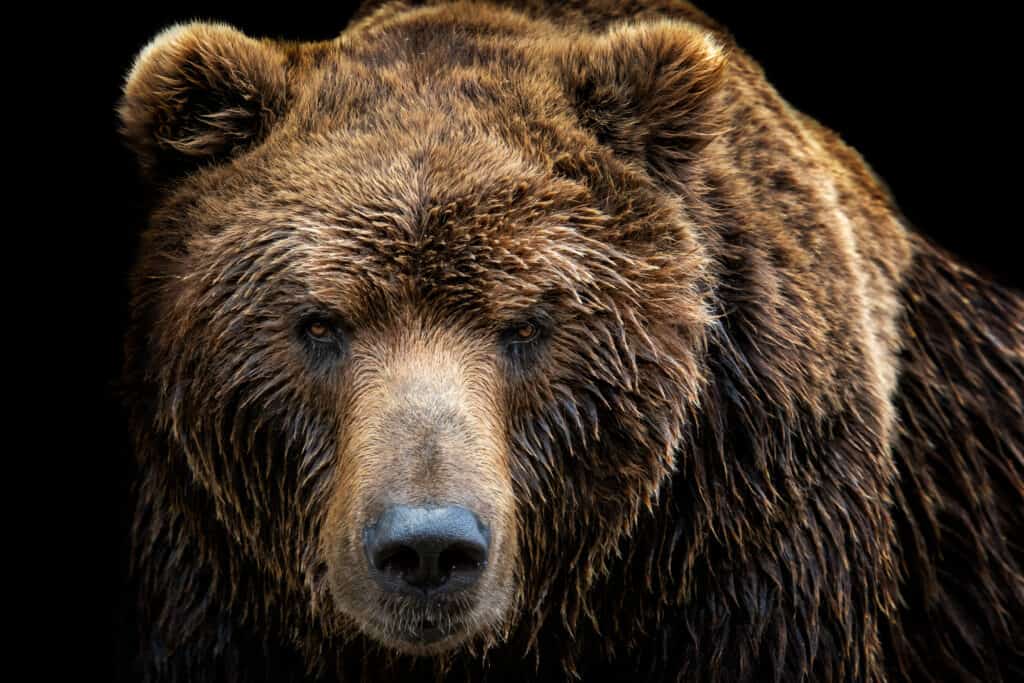
The largest bears ever caught in Montana have all been grizzly bears.
©Lubos Chlubny/Shutterstock.com
The record for the largest bear ever caught in Montana is shared by two hunters. Ted Johnston and E. Cameron both harvested grizzly bears with combined skull measurements of 25 and 9/16 inches. Ted Johnson killed his record bear in 1934 near the upper Boulder River. Meanwhile, E. Cameron bagged his bear near Missouri Breaks in 1890.
The Boone and Crockett Club keeps records of “trophy” kills for various big game animals, including grizzly bears. Rather than weight or length, it uses skull measurements to grade grizzly kills. To measure a bear skull, you measure the skull at its widest point (near the cheeks) and longest point (the base of the skull to the front teeth). You then add these two measurements and round to the nearest 1/16 of an inch to get the score. The Boone and Crockett Club also keeps a record of the largest bear by weight ever caught in the state. Currently, the heaviest bear on record in the state weighed a staggering 1,102 pounds!
In recent years, several large grizzly bears made the news due to their enormous size. The Lincoln Bear likely ranks as the largest bear killed in the state in the past few decades. This 12-year-old grizzly died in 2007 after a truck struck it on Highway 200 near Lincoln, Montana. At the time of his death, the Lincoln Bear stood nearly 8 feet tall and weighed 830 pounds. At that size, the Lincoln Bear ranks as the third-largest grizzly bear in state history.
A bear known as Maximus likely ranks as one of the largest Montana bears shot by a hunter in recent memory. This behemoth grizzly measured 7.5 feet tall and weighed slightly more than 800 pounds. Maximus resided near Dupuyer, Montana, during the early 2000s. When Mike Madel, an employee of the Montana Department of Fish, Wildlife, and Parks, discovered Maximus in 2007, the bear was already 765 pounds at just 7.5 years old. If Maximus lived longer, he almost certainly might have broken the state record for the largest grizzly. Unfortunately, a poacher shot Maximus sometime in 2009.
Where Is Missouri Breaks Located on a Map?
The area commonly termed the Missouri Breaks consists of Upper Missouri River Breaks National Monument, covering 375,000 acres of publicly held prairies and badlands in central Montana. It starts around Fort Benton on U.S. Highway 87, running parallel to the Upper Missouri National Wild and Scenic River, and ends 149 miles away at the point where Robinson Bridge (U.S. Highway 191) crosses the Missouri River.
Bears in Montana: Types and Appearance
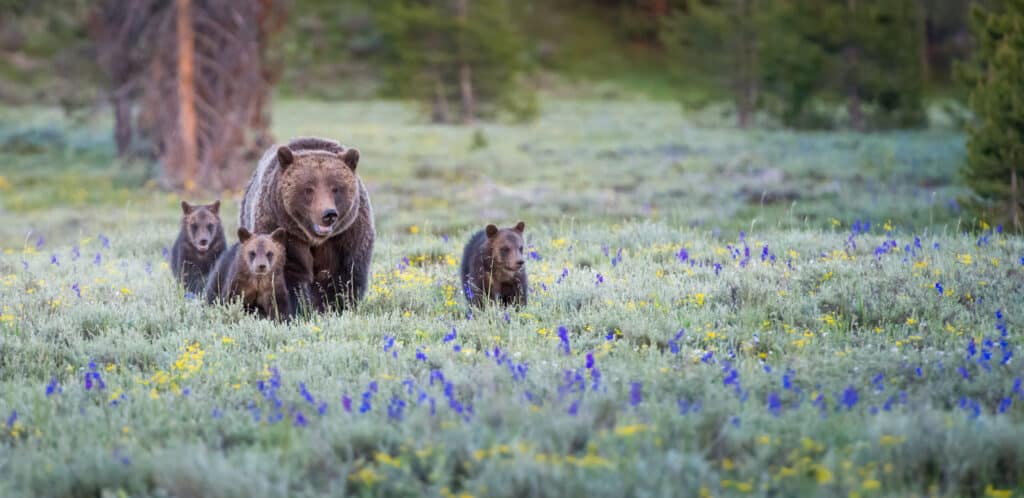
Two of the three bear species native to the United States live in Montana.
©iStock.com/Jillian Cooper
Of the three bear species found in North America, two are native to Montana. The state hosts large populations of American black bears (Ursus americanus) and grizzly bears (Ursus arctos). The other bear native to North America, the polar bear (Ursus maritimus), does not reside in Montana.
Color and size constitute the main differences between black bears and grizzly bears. Black bears generally sport a dense black coat, hence their name. Meanwhile, grizzly bears normally have light or dark brown coats. Their hairs often look white-tipped, which is where they get the name “grizzly,” from the word “grizzled,” meaning streaked with gray. In terms of size, adult black bears weigh between 90 and 500 pounds on average. While old males can grow upwards of 700 pounds, such bears occur rarely. Meanwhile, grizzly bears frequently tip the scales at 700 pounds or more. They frequently range between 400 and 800 pounds, with males typically weighing more than females.
Several other features noticeably differentiate grizzlies and black bears. Upon close examination, you’ll notice that grizzly bears sport a shoulder hump, while black bears feature no such hump. Additionally, the face profile of the two bears differs slightly. While grizzly bears have a “dished” face, black bears sport a “straight” face. Although both possess long claws, the claws of a grizzly bear can reach almost twice as long. On average, black bear claws grow to about 1.5 inches long, while grizzly bears have 2 to 4-inch claws.
Bears in Montana: Habitat
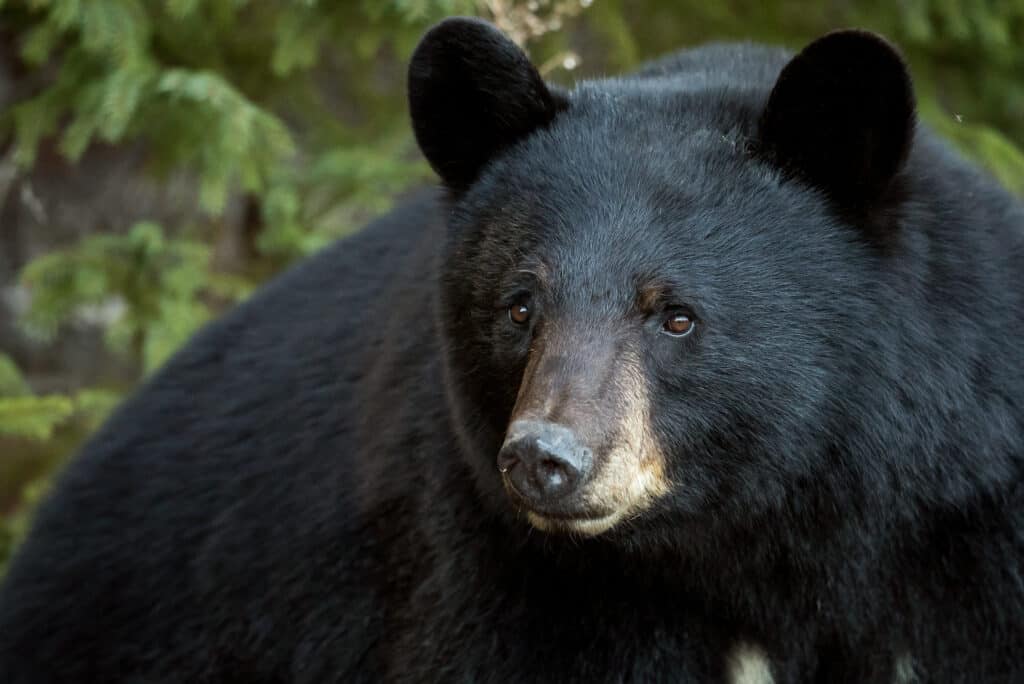
Historically, the range of black bears in the United States is greater than that of grizzly bears, but their habitats often overlap.
©iStock.com/Brittany Crossman
At one point, bears used to live throughout almost the entirety of North America. The historical range of grizzly bears covered all of the central and western United States, Mexico, and Canada. As for black bears, their range was even larger, extending from the Pacific Coast to the Atlantic Coast. Black bears and grizzly bears live in similar habitats. In fact, in many places, their ranges overlap, which can cause conflicts between bears. Both grizzlies and black bears commonly live near rivers, lakes, or streams with riparian vegetation. You can often find them in dense forests, as these environments provide both food and cover. Black bears and grizzlies both live at high and low elevations and in dry and wet climates. However, they both avoid dry desert regions and open prairie.
Until relatively recently, you could find bears throughout much of Montana. However, hunting and loss of habitat drove both bears out of parts of their historic range. Today, black bears range throughout central and western Montana. They may cover long distances between seasons to reach certain habitats. In spring, they frequently inhabit dry mountain meadows. Meanwhile, they frequent streams and wet meadows in summer. As for grizzlies, the remaining bears in the state reside in four ecosystems. These include the Cabinet Yaak, Northern Continental Divide, Bitterroot, and Greater Yellowstone ecosystems.
How Many Bears Are There in Montana?
Prior to the arrival of European settlers, around 250,000 grizzly bears lived in the lower 48 states. However, overhunting and habitat loss drove grizzlies out of most of their native territory. By 1975, fewer than 1,000 grizzlies remained. The passage of the Endangered Species Act in 1975 marked a turning point for grizzlies. Thanks to regulations like the ESA and others, these magnificent bears are slowly making a comeback in several states, including Montana. Today, experts estimate that between 1,800 and 2,000 grizzly bears live in Montana.
Similarly, the total black bear population in North America also plummeted in the 19th and 20th centuries. However, unlike the grizzly, black bears still live in much of their native range. Presently, Montana wildlife authorities believe that 15,000 or more black bears live in the state. Some experts think the number could be even higher.
Today, the total grizzly bear population in North America stands at around 55,000. Most of these bears live in Alaska and Canada, with only a small fraction residing in the contiguous United States. Meanwhile, the North American black bear population equals approximately 800,000. The IUCN currently classifies both grizzly bears and American black bears as a Least Concern species. However, the United States and Canada each treat grizzly bears with more caution. Both countries list grizzly bears as a Threatened species.
Is It Legal to Hunt Bears in Montana?
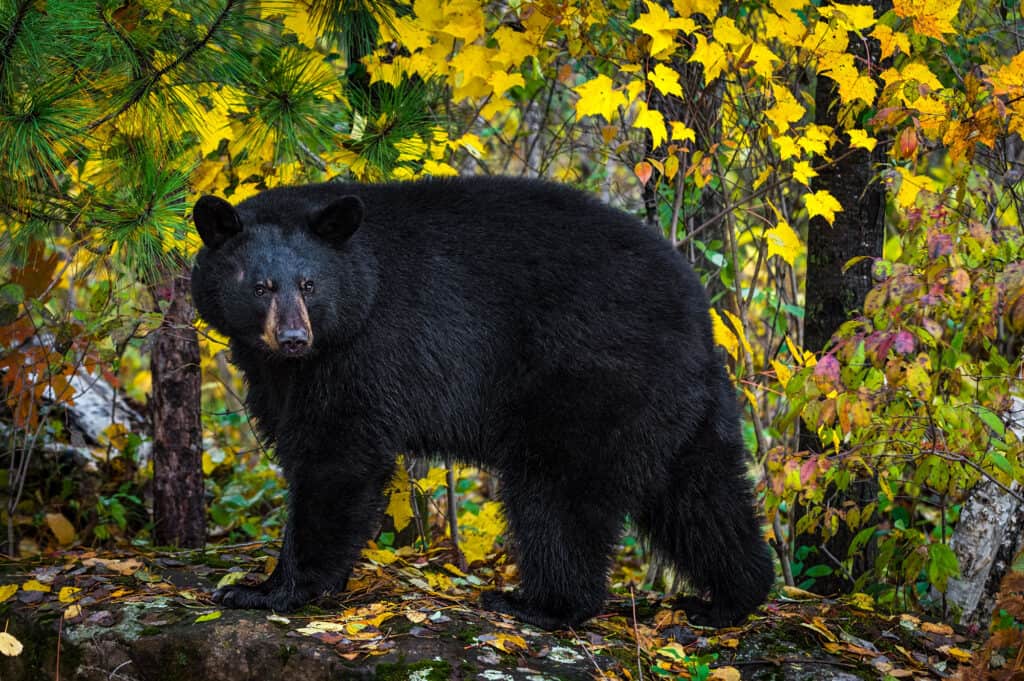
Currently, it is only legal to hunt black bears in the state of Montana, and even then, there are caveats.
©Holly Kuchera/Shutterstock.com
Montana allows the hunting of black bears during two designated hunting seasons each year. Meanwhile, it is currently illegal to hunt grizzly bears in Montana. However, the recent rise in grizzlies across the state has led some to question this ban. Despite the near eradication of grizzlies in the state, Montana allowed grizzly bear hunting in the northern parts of the state until 1991. Montana wildlife officials have recently requested to delist grizzly bears as an endangered species. This would allow the state to regulate the hunting of grizzlies within its borders.
In order to hunt black bears in Montana, you must first obtain a black bear hunting license. The state only allows hunters to purchase one license per year. Moreover, hunters born after January 1, 1985, must first complete a Montana hunter safety and education course prior to applying for a license. Montana forbids the following when hunting black bears:
- Firing from a motorized boat, airplane, or land vehicle
- The use of bait or salt licks
- Hunting more than one half-hour before or after sunrise
- The use of artificial projected light
- The hunting of black bear cubs (bears less than 1 year old) or females with cubs
- The hunting of radio-collared animals.
Prior to 2021, Montana forbade the use of dogs when bear hunting. However, a recent change in hunting regulations now allows eligible hunters to use dogs when bear hunting.
Are Bears Dangerous?
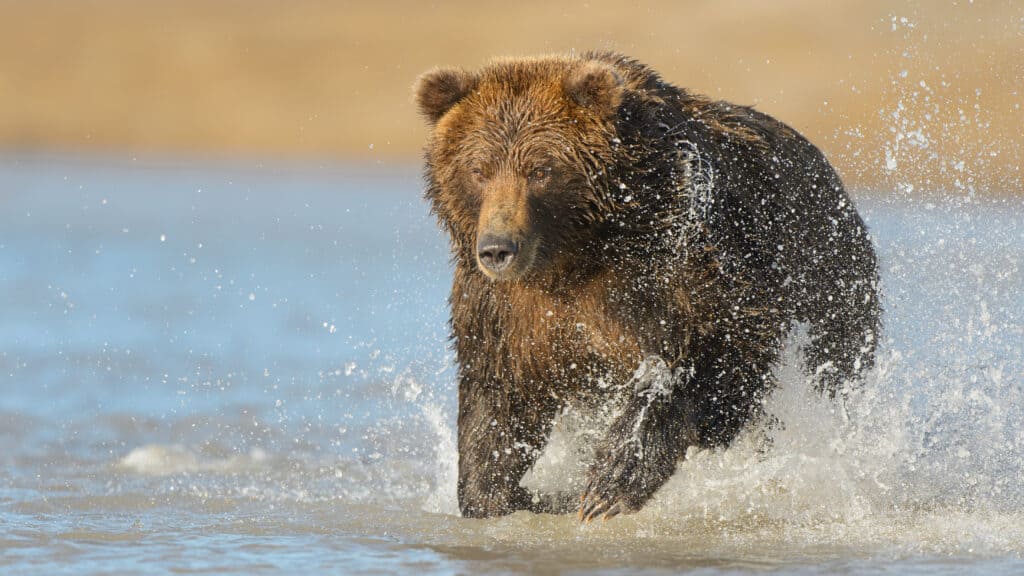
The average grizzly bear has the strength of five to seven humans.
© NaturesMomentsuk/Shutterstock.com
It should come as no surprise that bears are quite dangerous animals. According to estimates, an average grizzly bear possesses the strength of five to seven humans. A grizzly bear has a bite force of 975 psi, higher than either a lion or tiger. Bears can run up to 30 miles per hour over short distances and climb (or knock over) trees with ease. Some eyewitness reports mention witnessing grizzlies break the backs of moose or elk with a single blow. Such incredible feats of strength mean that a grizzly or black bear would have no trouble killing a person.
That said, bears pose little threat to humans. On average, black bears kill less than one person each year in North America. While the number is slightly higher for grizzlies, it still amounts to only 1 or 2 people killed each year. Given these numbers, that means you have about a 1 in 2.1 million chance of being killed by a bear.
Still, you should know how to handle yourself if you stumble across a bear in the wild. First things first, try to remain level-headed. Do not turn your back on or try to run from a bear — you wouldn’t get far if the bear decided to come after you. Instead, face the bear directly and try to quickly and quietly back away. Ideally, the bear will either ignore you or simply make a bluff charge and then leave you alone. Black bears, in particular, are notoriously timid, which makes attacks extremely rare. Grizzlies are slightly more aggressive but rarely actively prey on humans.
If a bear starts to move toward you aggressively, try to scare it off. You can accomplish this by making loud noises, singing, or banging objects together — pots and pans usually do the trick. Similarly, you can try to fool a bear into thinking you measure bigger than you actually are. To do this, simply wave your arms over your head, or stand next to someone if you’re not alone. In the event that a grizzly gets within striking distance of you, don’t try to fight, play dead. Hopefully, the bear will lose interest in you and wander away, giving you time to retreat.
On the other hand, if a black bear attacks you, don’t play dead; stand your ground and fight. Rocks and sticks make great improvised weapons. Aim your blows at the bear’s face, and yell as loud as you can to scare the bear or attract help. As a precaution, always carry bear mace and an air horn with you when hiking or camping in bear country.
Conclusion
Montana represents one of the last great bastions of black and grizzly bears in the United States. Numerous giant bears once roamed the Montana wilderness, and some turned into living legends. With the recent push to legalize grizzly hunting in the state, the record for the largest bear ever caught in Montana may once again be up for grabs.
Up Next…
- Discover the Largest Bear Ever Caught in Ohio
- Discover the Largest Bear Ever Caught in Massachusetts
- Discover the Largest Bear Ever Caught in Oregon
- Discover the Largest Bear Ever Caught in Missouri
- Discover the Largest Bear Ever Caught in Alabama
The photo featured at the top of this post is © Scott E Read/Shutterstock.com
Sources
- , Available here: https://www.greatfallstribune.com/story/news/local/2016/07/18/famous-grizzlies-montana/87168708/
- , Available here: https://fwp.mt.gov/hunt/biggamerecords
- , Available here: https://crownofthecontinent.net/entries/the-lincoln-grizzly-lincoln-montana/ea4d811b-408f-480c-9f2b-a12a644efca4
- , Available here: https://fwp.mt.gov/conservation/wildlife-management/bear/all-about-bears
- , Available here: https://freerangeamerican.us/hunting-montana-grizzly-bears/#:~:text=Yellowstone%20and%20Montana%20grizzly%20bears%20have%20been%20protected,grizzlies%20be%20once%20again%20allowed%20in%20northern%20Montana.
- , Available here: https://fwp.mt.gov/binaries/content/assets/fwp/hunt/regulations/2022/2022-black-bear-final-for-web.pdf
Thank you for reading! Have some feedback for us? Contact the AZ Animals editorial team.




